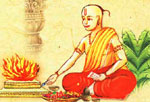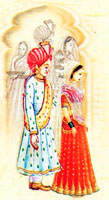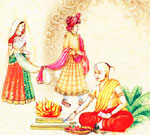Indian Wedding Ceremony Marriage Cards
Mehendi and Peethi
On the day prior to the wedding ceremony, the bride's palms and feet are painted with "Mendhi" and a canopy is set up for the wedding day. On the morning of the wedding, rituals are separately performed at the bride's home and groom's home. This includes anointing with turmeric, oil, and a paste of sandalwood and bathed to cleanse and soften the body. Vedic mantras are chanted during bathing.
|
Laya (Laja) Homa
This is a sacrifice of parched grain offered by the bride to the Gods. Her brother pours grain into her hands, saying "This grain I spill, may it bring to me wellbeing and unite you to me. May Agni hear us." He asks the bride to spill the grain in the fire, saying "This woman scattering grain into the fire, prays. Blessings on my husband and may my relatives be prosperous."
|
 |
 |
Baarat
This is the wedding procession. The groom arrives in procession with friends and family and is acknowledged by the bride's family and close friends.
|
|
Commencement of the Marriage
The marriage commences with the priest under the canopy. Blessings are invoked on behalf of the couple. The bride presents the groom with yogurt and honey to symbolize pureness and sweetness. The bride places a garland on the groom's neck and he places a garland around her neck. The priest summons memories and blessings of the forefathers of the couple and they are congratulated by the guests.
|
 |
 |
Kanya Danam
This part of the celebration is when the daughter is given away. The bride spreads turmeric powder on her hands to symbolize acceptance of her change in status to wife. For Kanya Danam, the father pours out sacred water to symbolize giving the daughter to the groom. Vedic hymns are recited by the groom to Kama, God of love. The father requests a promise of the groom to assist the bride in apprehending the three ends: dharma, Kama, and artha and the groom repeat three times that he will now fail the bride in attaining the three ends.
|
|
Paanigrahana or Hasta Milap
The groom stands facing to the west and the bride is facing east. He holds her hand and performs Vedic hymns for happiness and an enduring relationship. |
 |
.jpg) |
Vivaaha
During the vivaaha, or wedding, the bride and groom stand facing each other, while the priest takes the bride's saree and ties it to the groom's shirt to symbolize the union. The bride and groom exchange garlands and rings. The nuptial fire is installed and worshiped. This fire symbolizes the celestial witness to the sacrament. The bride and groom hold hands and pray for blessings. Samagee, which is a mixture of sandalwood, herbs, rice, ghee, sugar, and twigs is offered to the fire to seek blessings. |
Agni Parinaya – Walking Around the Fire
The couple holds hands and walks around the fire three times, while reciting Vedic hymns and offering oblations. They place a hand on each other's heats and pray for their hearts and minds to be united. The groom repeats, "First now they bring to you in bridal procession this Surya, guiding her steps in circular motion. Return her now, O Agni, to her husband as rightful wife, with hope of children to come.". The rite is repeated two more times and on the fourth time around, the bride pours the fried grain in, while saying "To Bhaga Svaha!"
|
 |
Asmaarohana or Shilarohana – Mounting the Stone
Each time the couple passes around the nuptial fire, they stride on a stone, while offering a prayer for mutual love as steadfast as the stone.
 |
Satanadi or Seven Steps
This most important rite of the wedding ceremony is the seven steps taken around the nuptial fire. At each step, a promise is made and the groom sings the symbolism of each of the seven steps, including to:
- nourish each other
- grow in strength together
- preserve wealth
- share joy and sorrow
- care for our children
- stay together forever
- stay lifelong friends
The bride says, "With seven steps together, we become friends. Let me reach your friendship, never be severed from your friendship and let your friendship not be severed from me." The ceremony continues with a prayer and the couple becomes husband and wife. In Gujarati, four steps are taken to symbolize Dharma, Artha, Moksha, and Kama. |
Mangal Sutra Dharana
This is the tying up of a thread, which contains the marks of Vishnu or Shiva around the bride's and groom's neck.
Suhaag or Sindhoordana
The groom puts a red powder in the bride's hair to symbolize that she is married.
Post Marriage Games
There are regional variations in the games that are played.
Aeki-Beki
This game is played in the home of the groom. A ring and coins in a tray of water are colored with vermillion and milk. The person finding the ring four times rules the house.
Talambra
In many marriages in south India, rice and turmeric are mixed and poured by the bride and groom on the head of the other and singing and games bring the couple closer together.
Arundhati Darshan
This is the showing of the Saptha Rishi Mandala and the small star Arundhathi under the star of Vashistha. The seven sages are the origin of Vedic Lore of the Hindus. The seven stars of the Great Bear constellation are named for these sages and the ritual reminds the bride and groom of their cosmic responsibilities.
Dhruva Darsahn – Looking at the Polestar
When the sun has set, the groom shows the bride the polar star and says, "You are firm and I see you. Be firm with me, O nourishing one! Brhaspati has given you to me, so leave with me a hundred ears and bear children by me, your husband."
Aashirvaad
The couple is blessed by the groom's parents and they present the bride with a flower or cloth to symbolize her joining the groom's family. The couple is showered by the guests with flowers. |
|
Grahapravesha – Entering the Home
The bride and groom from the bride's house for the home of the groom. The sacred fire is carried in a vessel to be kept alight. When they reach the house, the groom says, "Enter with your right foot. Do not Remain Outside." The bride enters with her right foot first and the mother of the groom welcomes the bride with an arati. They sit in silence until the stars can be clearly seen in the sky.